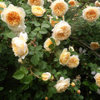Gonna try posting again! Black Spot?!
mystic_dragon72
14 years ago
Related Stories

UPHOLSTERYSeeking a Quiet, Relaxed Spot? Try Upholstering Your Walls
Upholstery can envelop an entire room, a framed panel or a single wall. See some design options and learn what to expect
Full Story
REMODELING GUIDES11 Reasons to Love Wall-to-Wall Carpeting Again
Is it time to kick the hard stuff? Your feet, wallet and downstairs neighbors may be nodding
Full Story
DECORATING GUIDESKnot Again! Macrame Is Back
It's happened. A craft that typified 1970s style (the owls, the spider plants!) is back, but better
Full Story
BUDGET DECORATING12 Ways to Make Your Home Feel New Again
Treat your furniture, walls, floors and countertops to some TLC, to give them a just-bought look for a fraction of the cost
Full Story
HOUSEKEEPING10 Problems Your House May Be Trying to Show You
Ignore some of these signs and you may end up with major issues. We tell you which are normal and which are cause for concern
Full Story
HOUSEKEEPINGGot a Disastrously Messy Area? Try Triage
Get your priorities straight when it comes to housekeeping by applying an emergency response system
Full Story
COLOR12 Tried-and-True Paint Colors for Your Walls
Discover one pro designer's time-tested favorite paint colors for kitchens, baths, bedrooms and more
Full Story
DECORATING GUIDES28 Decorating Moves to Try This Month
Treat your interiors to a pick-me-up with these quick and cheerful decorating tricks
Full Story
LIFELate Again? Eliminate the Things Holding You Up in the Morning
If you find yourself constantly running late for appointments, work and get-togethers, these tips could help
Full Story
BATHROOM DESIGNSpotted: Refrigerators in the Bathroom
You read that right. Before you protest, here are seven good reasons why people are chilling in the bath
Full Story





york_rose
mystic_dragon72Original Author
Related Discussions
Heartbroken, black spot problem again this year!
Q
gonna try pampas grass again
Q
Trying Yet Once Again To Post Pictures
Q
trying again, I think posting is getting harder all the time
Q
jont1
buford
Terry Crawford
henry_kuska
york_rose
mystic_dragon72Original Author
jim1961 / Central Pennsylvania / Zone 6
diane_nj 6b/7a
mystic_dragon72Original Author
henry_kuska
diane_nj 6b/7a
michaelg
buford
york_rose
henry_kuska
mystic_dragon72Original Author
henry_kuska
michaelg
buford
henry_kuska
scottys
dublinbay z6 (KS)
buford
henry_kuska
york_rose
york_rose
henry_kuska
henry_kuska
mystic_dragon72Original Author
scottys
buford
michaelg
henry_kuska
henry_kuska
ramblinrosez7b
york_rose
buford
ramblinrosez7b